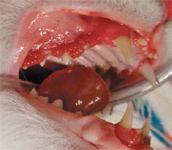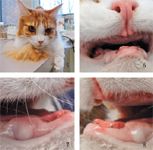Dental corner: Stomatitis in a Maine Coon cat
Full mouth extractions offer hope for a cat with widespread oral inflammation.
Gabriel, a 2-year-old neutered male Maine Coon cat, was presented to Animal Dental Center for evaluation of severe gingivitis. Clinical signs started when he was around 6 months old and continued to progress—he avoided dry food, occasionally would have bloody discharge from his mouth and stopped self-grooming.
Examination
Upon examination, it was discerned that Gabriel didn't have gingivitis, he had stomatitis. Stomatitis is a term used to describe widespread oral inflammation beyond gingivitis and periodontitis that may extend into the submucosal tissues. This condition is often characterized by persistent inflammation and ulceration of the oral mucosa. Clinical signs include excessive drooling, "chattering," halitosis, dropping food and oral pain. Stomatitis affects cats of any age or sex, but it seems to be more common in Maine Coon cats.

Photo 1: Gabriel presented for evaluation of severe gingivitis. An examination showed he suffered from stomatitis. (PHOTOS COURTESY OF ANIMAL DENTAL CENTER, YORK, PA.)
The true cause of stomatitis is unknown. However, it is thought to be an immune-mediated disease, characterized by an aggressive immune response to an allergen (plaque). There may be a dietary, infectious or concurrent viral component, along with periodontal disease or tooth resorption.
A dental technician obtains blood samples and performs a preoperative physical exam.
Treatment
Treatment of stomatitis varies, from antibiotic or corticosteroid therapy to selective extractions. A 1997 study stated that 60 percent of cats will be cured by full mouth extractions.1 Treating any concurrent disease or condition alone will not cure stomatitis.2 The doctors at Animal Dental Center recommended full mouth extractions for Gabriel, and the owner agreed.

Photo 2: Gabriel suffers from severe inflammation often seen with stomatitis. Note the ulceration, gingivitis and friable-looking tissue extending over the mucogingival line.
Gabriel was admitted to the hospital, and the results of preoperative blood work were normal. He was anesthetized, hooked up to monitoring equipment and given intravenous fluids.
Intraoral radiographs were obtained, and none of the teeth or bones were shown to be affected by tooth resorption or periodontal disease. An oral examination showed severe gingivitis and mucositis, with proliferative caudal tissues and sublingual inflammation. Regional nerve blocks with bupivacaine were administered to all four quadrants, and all 30 teeth were surgically extracted. Immediately postoperatively, a 12-μg fentanyl patch was placed on his thorax.

Photos 3 & 4: The ulceration is especially severe where the gingiva attaches to the tooth.
Gabriel's recovery was uneventful. He was sent home with oral buprenorphine as an adjunct to the fentanyl patch, along with an Elizabethan collar.
The dental technician is also responsible for administering, monitoring and recovering the patient from anesthesia, reviewing home-care instructions with clients and performing follow-up appointments and callbacks.
Follow-up
At a two-week recheck, the inflammation was markedly reduced and Gabriel was eating well. At a four-week recheck, minor inflammation was present, but the overall results were good.

Photos 5-8: Gabrielâs mouth four weeks after the operation.
Patricia March, RVT, VTS (Dentistry), is a dental technician at Animal Dental Center in Baltimore, Md. March will lead the Focus on Dentistry: Dental Techniques for Technicians course and the Focus on Dentistry: Nerve Blocks for Dental Procedures lab at CVC in Kansas City, Aug. 23 to 26. Visit thecvc.com to learn more.
References
1. Hennet P. Chronic gingivo-stomatitis in cats: long-term follow-up of 30 cases treated by dental extractions. J Vet Dent 1997;14:15-21.
2. Beckman, B. Veterinary Dentistry-Feline Stomatitis Update (oral presentation). 24th Annual Veterinary Dental Forum, San Antonio, Texas. Oct., 2010.